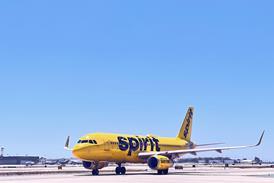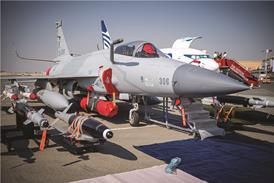The Finnish air force is preparing to accept its first upgraded Boeing F-18C/D Hornet back into operational service this coming April as part of ongoing modernisation activities linked to the development of a coalition operations capability in support of co-operative European defence.
Core decisions on a follow-on upgrade for the fighters is also expected over the next four months, with this to introduce an initial Link 16 tactical datalink capability and select a long-range stand-off ground-attack missile.
In parallel, Finnish authorities are preparing to consider proposals for the development of an expanded airlift capability with provisions for air-to-air refuelling. An options study is now at an advanced stage and is due to be considered by the government early in 2007.
Finland plans to hold six upgraded F-18s and 150-210 airmen at a high level of operational readiness as part of the counter air operations component of any European rapid deployment force, says chief of air force Lt Gen Heikki Lyytinen, with these to be available from 2010.
As an interim milestone, however, Finland will hold major air defence exercises in 2008, incorporating a full tactical evaluation of its planned EU contribution. These are planned to include air-to-air refuelling missions, with planning now under way for the lease of a capability from a second nation.
The air force's second group of pilots trained in air-to-air refuelling practices took part in French-led exercises in Dijon, France, in October, but the development of a national capability remains an important priority, says Lyytinen.
The current airlift study is examining options for the acquisition of platforms that could have dual-use application. "We have a study, which is led by our ministry of defence, to see if there are any possibilities for Finland for strategic or tactical airlift and if the same could be the solution for air-to-air [refuelling]," says Lyytinen.
One innovative solution that is seen as "very effective" by Lyytinen is a possible joint arrangement with Finnair, the government-owned national carrier, based on the purchase of Airbus A330 multi-role tanker transports (MRTT).
"Finnair could use an A330 MRTT aircraft in their daily use to have cargo and tourists, but we could also hire time on the aircraft for our air-to-air refuelling training and for our exercises. And why not also those international exercises where Finland is a player?"
The options study includes participation by a number of other Finnish government ministries and agencies, and could result in any eventual aircraft acquisition being made available for use as a national response asset in times of emergency. The 26 December 2004 tsunami in South-East Asia is a case in point, says Lyytinen. "That aircraft could be used by the government of Finland to rescue Finnish tourists."
If the concept gets the green light, the costs of the aircraft purchase would be shared across several government budget lines, including defence. "I hope it goes," says Lyytinen. "In my opinion, it could be a very practical solution for a small country to have that capability. In a way, I also think that if something happens in Finland and we really need the capability for defending our own country, we can be sure we have that capability."
Any new airlift capability would exclude provisions for carriage of heavier types of defence equipment, such as armoured personnel carriers. "From our level in Finland, we must always think that heavier equipment, tanks and those vehicles must be sent by sea to meet any deployment requirements," he adds. The air force recently ordered two EADS Casa C-295s are candidates for inclusion in any such future Finnish involvement in European battlegroup missions.
Mid-life upgrade
Finland's initial F-18 mid-life upgrade - or MLU1 - has now reached the operational evaluation phase for the lead aircraft. The programme is intended to enhance within visual-range combat capabilities and introduces the Raytheon AIM-9X Sidewinder short-range air-to-air missile, joint helmet-mounted cueing system, a combat interrogator and digital moving map. Full-fleet role is targeted for completion by the beginning of 2009.
The follow-on MLU2 is necessarily "more complex", says Lyytinen, partly because Boeing and the US Navy are planning to end significant evolution of the OMNI integrated software system for pre-E/F series F-18s next year. Finland is required to provide Boeing with detailed guidance on its requirements for software changes by early in the second quarter 2007, including all new subsystem and missile requirements. "Boeing is not doing any more big software changes and that is the last big software improvement," says Lyytinen. "Of course, if you have enough money, you can do whatever, but practically that will be the last chance to have a very big software change and that is a challenge for us."
MLU2 is structured in three parts, focusing on interoperability, survivability and air-to-ground lethality and is intended to sustain the aircraft out to their life of type in 2025-30. Multiple elements of the project remain to be contracted, with the full capability not expected to be achieved until 2015. The proposed stand-off missile is unlikely to be acquired until 2012, says Lyytinen, but decisions effectively have to be made soon. "We have some time to investigate what the right solution is, but to get the software the easy way, we are now a little bit busy."
Release politics
Restricted tenders for the air-to-ground requirement were released mid-way through this year. The baseline is the Raytheon Joint Stand-Off Weapon "or more, and more or less we are looking at weapons like SLAM-ER, Taurus and [Lockheed] JASSM", he says. But access to the US-sourced weapons remains an issue. "There is the problem of what weapons you can have because of the release politics. We have some ideas of what they could be for us. For example, JASSM is not so easy - we know that very well. Australia is the only country that has got it, but we are looking forward." In contrast, Finland has secured release approvals for the Boeing SLAM-ER, says Lyytinen.
Consideration is also being given to an anti-radiation missile as part of the air-to-ground capability mix with Finland including the Raytheon AGM-88E advanced anti-radiation guided missile in its MLU2 foreign military sales application, notified to US Congress in September. That application formed part of clarifying "which weapons are releasable for us", says Lyytinen.
The MLU2 interoperability focus will see the limited roll-out of Link 16 via the proposed purchase of Multifunction Information Distribution Systems - Low Volume Terminals terminals. This will operate alongside Finland's own national link system, which will remain fitted to the F-18 fleet for the foreseeable future to meet specific national requirements.
Lyytinen says an interface between the two systems is still under consideration as part of ongoing interoperability studies. "To make it is probably very expensive, but we have not made any final decision."
The survivability element will see the upgrade of the fighters' APG-73 radar and the fitting of new electronic warfare self-protection systems, with the suite potentially including the Raytheon ALR-67(V)3 radar warning receiver as well as new chaff and flare dispensers.
A new active jamming capability is also possible, says Lyytinen, although the service already fields the ALQ-165 airborne self-protection jammer. "We have thought about towed decoys systems and such, but with the MLU2 we are in the planning phase and don't yet have any decisions. We are trying to find solutions that are good for us and you always have the other thing, which is the money."
Ground strike
Development of the planned long-range ground strike capability is acknowledged by Finland's 2004 defence white paper as requiring a deep reconnaissance and target acquisition capability. Lyytinen says that although acquisition of the Raytheon advanced tactical forward-looking infrared sensor is being examined as part of MLU2, "that is not enough", given the types of weapon proposed.
Defence minister Dr Seppo Kääriäinen says the most likely solution will comprise "effective UAVs and modern sensors", with the Finnish defence industry currently conducting an extended study of options under a sponsored national technology study. Based on evaluation, says Kääriäinen, the developmental EADS new-generation networked UAV - or Agile - programme "is seen as a potential solution to fulfil the Finnish performance requirements".
Lyytinen confirms that the UAV option is one of a number of options under study. "We are working closely together with our defence staff for that." n
Source: Flight International























